-
Medical journals
- Career
Impact of the opening manoeuvre on gas exchange, haemodynamics and the splanchnic circulation in ARDS patients
Authors: V. Zvoníček; V. Šrámek
Authors‘ workplace: Anesteziologicko-resuscitační klinika, Lékařská fakulta Masarykovy univerzity a Fakultní nemocnice u sv. Anny v Brně
Published in: Anest. intenziv. Med., 17, 2006, č. 4, s. 208-212
Category: Intensive Care Medicine - Original Paper
Overview
Objective:
To perform the recruitment manoeuvre (RM) in ARDS patients according to transalveolar pressure (Ptrans = airway pressure minus oesophageal pressure) and to evaluate its impact on gas exchange and the global and splanchnic haemodynamics.Design:
Prospective, interventional study.Setting:
Department of Anaesthesia & Intensive Care, St. Anna University Hospital, Brno, Czech Republic.Methods:
Patients in the early phase of ARDS were enrolled in the study. RM was performed in the CPAP mode for 40 seconds; the aim was to reach transalveolar pressure (Ptrans) of 30 cm H₂O measured by a special bedside respiratory monitoring system.The haemodynamics and blood gases from the pulmonary, radial and hepatic arteries were measured 2 minutes before (preOM), and 2 and 30 minutes after the RM (OM2, OM30). Friedman ANOVA was used for statistical analysis. The data are presented as median and interquartile range.Results:
Nine ARDS patients were included. During the RM, CPAP of 50 (49–53) and 24 (20–25) cm H₂O was used. Ptrans was reached. MAP decreased by 33% (7–61%) during the RM (P < 0.001). Other haemodynamic parameters were not statistically significantly different except for an increase in the cardiac index (CI) from 3.8 (3–4.3) preOM to 4.4 (3.2–5.1). Oxygenation did not improve during the RM. The PaO₂/FiO₂ index was 193 (163–199), 195 (166–195) and 165 (154–199) preOM, OM2 and OM30 respectively, P = 0.54. A significant increase in PaCO₂ to 4.8 (4.0-5.2) and 4.9 (4.5–5.5) kPa was observed after the RM (P = 0.02, P = 0.05). The difference in oxygen saturation between the pulmonary and hepatic arteries (SvO₂-ShO₂) also did not change: 15.3 (8.7–24.1), 18.8 (12.6–23.3), 22.9 (14.0–30.6) at preOM, OM2 and OM30 respectively (P = 0.23).Conclusion:
During the RM the transalveolar pressure of 30 cm H₂O was not reached in any patient. The RM caused a temporary but significant MAP decrease and did not change oxygenation or the splanchnic circulation.Key words:
ARDS – recruitment manoeuvre – haemodynamics – splanchnic circulation
Labels
Anaesthesiology, Resuscitation and Inten Intensive Care Medicine
Article was published inAnaesthesiology and Intensive Care Medicine

2006 Issue 4-
All articles in this issue
- Death of a novice scuba diver after sudden emergence from a 5-meter depth – case report
- New developments in haemodynamic monitoring: Part I
- New developments in haemodynamic monitoring: Part II
- Experience of anaesthesiologist from Korean War
- Perioperative spinal cord monitoring during spinal surgery
- Transient language disturbances following anaesthesia in bilingual patients – case reports
- Difficult Airways – prediction and management
- Evaluation of tissue perfusion by microdialysis technique with 3H₂O indicator in the rat model of haemorrhagic shock
- Impact of the opening manoeuvre on gas exchange, haemodynamics and the splanchnic circulation in ARDS patients
- Anaesthesiology and Intensive Care Medicine
- Journal archive
- Current issue
- Online only
- About the journal
Most read in this issue- Difficult Airways – prediction and management
- Death of a novice scuba diver after sudden emergence from a 5-meter depth – case report
- Perioperative spinal cord monitoring during spinal surgery
- New developments in haemodynamic monitoring: Part I
Login#ADS_BOTTOM_SCRIPTS#Forgotten passwordEnter the email address that you registered with. We will send you instructions on how to set a new password.
- Career

